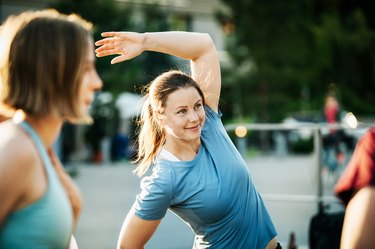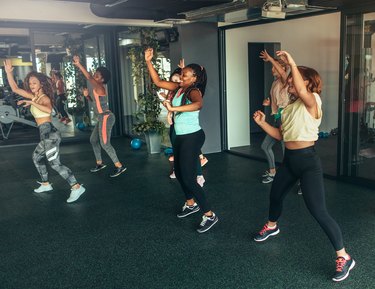Together with Athleta, we're compiling actionable wellness advice you need from the experts—and Well+Good is bringing it to life all year long at events in NYC. Here, disability advocate and model Mama Cax shares how to find a workout that works for you.
When life throws something difficult at you—whether it's a serious illness or injury—it can be hard to feel empowered in your body again. So how can you find the same joy in working up a sweat that you once did after a huge transition?
Video of the Day
Video of the Day
Just ask Mama Cax—model, blogger, and body positivity and disability advocate—who found a way to fall back in love with her active lifestyle again after battling bone cancer and having her leg amputated. According to the total body-empowerment inspiration, it's all about finding the workout that meets you where you are right now.
Keep reading for her top four tips on how to adapt your workouts to fit your new reality—so you can start reaping the good-for-you benefits ASAP.
1. Be Resourceful
Your path to finding your ideal workout match starts with doing a little research, but you might need to get creative in your investigative methods if you're looking for exercises specifically tailored to your needs.
"Typically, wellness and fitness pages only feature fit and thin, abled bodies," Cax says. "With social media, it's easier than before to find pages that cater to your body type, whether you want to find workouts or simply a little motivation."
So if you're curious about how certain activities would work with your concerns, hit up blogs or Instagram hashtags to find people who've done the research for you. "Someone out there has gone through what you are going through, and maybe they'll be able to offer some advice or help," Cax says.
2. Start Somewhere
When you're getting back into working out after experiencing a major setback, the important thing is to just get started.
"You won't be at the same level you were before, but don't beat yourself up," Cax says. "Restarting is not failing." So go ahead and take the workout class, sign up for the rec sports league, or simply lace up your sneakers and go for a walk. You'll never improve if you don't start.
3. Don't Let Others Hold You Back
Speaking of not beating yourself up, remember not to put too much stock in what other people think about your comeback, either. Take a page out of Cax's book and treat any negativity thrown your way as a challenge to rise above.
"I rise above any negative or limiting comments people make about my abilities by proving them wrong every single time," Cax says. "I love a challenge."
4. Find an Activity That Is Fun for You
The best workout is the one you'll actually do, so finding something you enjoy is key to making your active lifestyle stick. Before her surgery, Cax loved swimming, running, and playing basketball. Instead of giving up on those passions post-surgery, she figured out how to adapt them to her new reality.
"I taught myself how to swim again and focused on building my upper body so that I'd be able to rock climb without much lower limb strength," she explains. "I also didn't stop playing basketball. I started exploring adaptive sports and learned that I could play wheelchair basketball."
Take inventory of the types of exercise that make you feel excited to get moving. If going for a run is the most boring activity you can imagine, don't do that! If spending time outside lights you up, opt for yard work as your workout of the day. The endorphins and total-body benefits count just the same, no matter which modality you choose.

